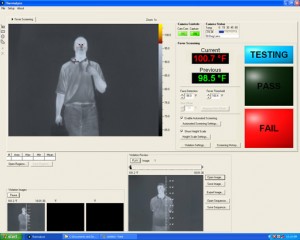
You feel lousy. Some old lady sneezed on you in the subway. Now you’re achy and tired and feverish. Face it, Bud. You’ve got the flu. Better just crawl back into bed.
What’s that? You have to fly to London? You’ve got an important meeting with a client? Well, I guess I can’t stop you. But someone else can. It’s the airport fever police. They spotted your hot head with their thermal scanner as you made your way into the airport.
No, you’re not living in George Orwell’s Airstrip One. Mass fever screening already exists. Airports began installing infrared detectors during the 2003 SARS outbreak. Last year, they ramped up their fever-scanning efforts when the H1N1 pandemic took hold.
When I first read about these devices, I envisioned the radar guns that highway patrol officers use to catch speeders. But the real devices look more like cameras. They measure the infrared energy emitted by your face. If your face is too hot, you may have a fever. The machine alerts the operator (or everyone via an alarm).
Thermal scanners are expensive, in the range of $15,000 to $30,000. But they could be a real boon to public health. Stop someone with a fever from boarding a plane and you not only protect their fellow passengers, you also keep them from transporting their illness (if it is indeed infectious) halfway around the world. But do these devices work? A study in the November issue of Emerging Infectious Diseases says, yes, some of them do. (Not everyone, of course, would agree.)
Researchers at the Centers for Disease Control and Prevention tested three different scanners in three emergency rooms. They scanned 2,873 adults, asked each person if he or she had a fever, and took their temperatures orally. The best two scanners were able to detect fevers in roughly 90% of those who actually had a fever. They weren’t so good at picking out the people who didn’t have a fever, however. Specificity for the best two scanners ranged from 86% to 80%. That means that the machine thought some people had a fever when they actually didn’t.
That could be a problem. A 2009 literature review on the topic put it this way: “Hostile reactions may arise among a high proportion of passengers mistakenly classified as febrile by the sensors and subsequently referred for medical examination.” Um, yeah. I would be pissed if I missed my flight because some idiot machine thought my face seemed hot. Wouldn’t you?
The devices tested in this study require the person being scanned to stand still. Others, like the Meditherm 520, can read people’s temperatures while they walk “at a normal speed.” So you could theoretically scan people without them knowing. And that brings up a whole separate issue. Security is already tight in the wake of 9/11. I have to remove my shoes at the airport and stuff my liquids into a tiny baggie. My loved ones can’t meet me at the gate. The police can search my bags on the subway. Will new concerns about emerging infectious diseases lead to even more restrictions? The whole thing feels just a little bit too Big Brotherish for comfort. Even the terminology is militaristic. One manufacturer — OptoTherm — calls a potential fever a “violation.”
OptoTherm’s Web site has a video that demonstrates how their system would work in the real world. First, you get everybody to form a single-file line. As people file through the screening station, the machine says, “Please stand still and look directly at the camera.” If the person “passes” — that is, if he or she doesn’t have a fever — it says, “Thank you. You may proceed.” If the person “fails,” he or she is instructed to wait for an attendant.
But then what? Perhaps what makes this device a valuable public health tool versus one more creepy way of keeping tabs on the masses is what happens after you fail. Are you sent home? Are you put into quarantine? Last year, Indonesia was spraying feverish passengers with a 70% alcohol solution, and then quarantining them for examination. Now that’s a bad trip.
Image credit: OtpoTherm